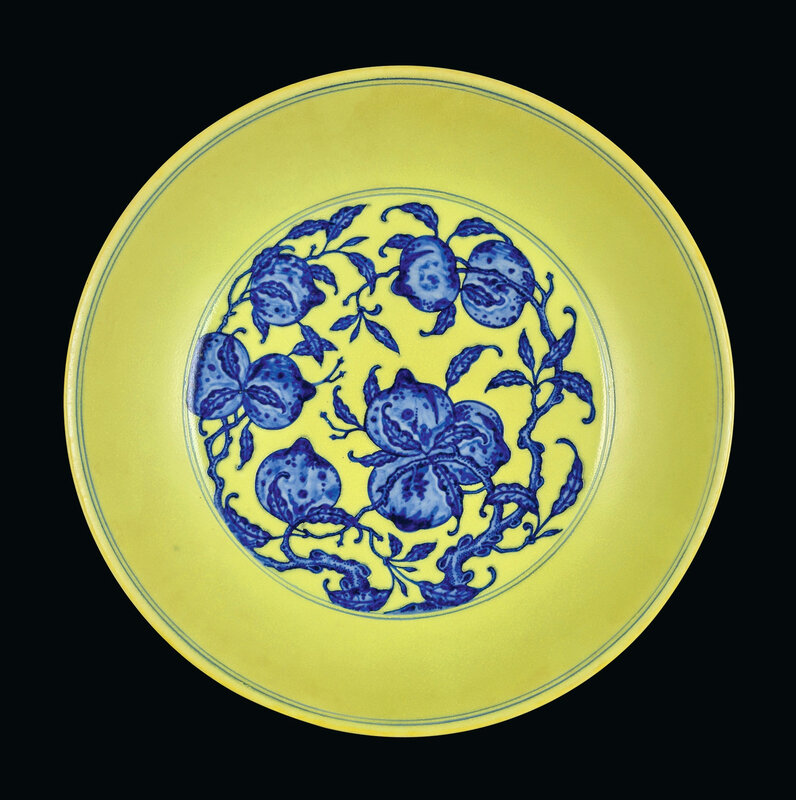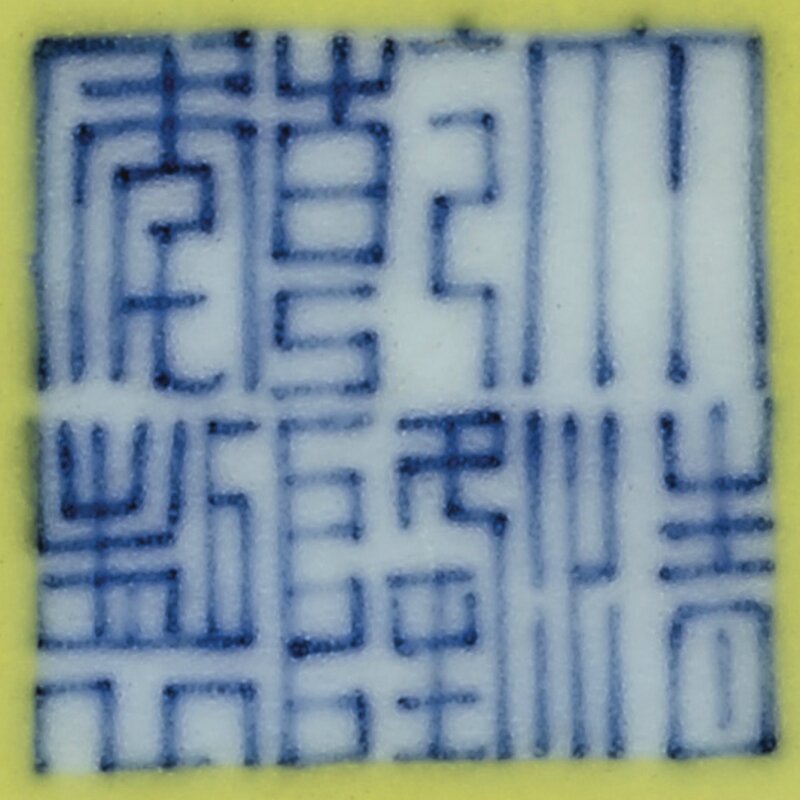A lemon-yellow-ground underglaze-blue 'nine peaches' dish, seal mark and period of Qianlong (1736-1795)

Lot 115. A lemon-yellow-ground underglaze-blue 'Nine peaches' dish, seal mark and period of Qianlong (1736-1795); 26.7 cm, 10 1/2 in. Estimate 900,000 — 1,200,000 HKD. Lot sold 1,062,500 HKD. Photo: Sotheby's.
the shallow interior decorated with a medallion in inky tones of cobalt-blue with nine peaches borne on gnarled leafy branches, the succulent ripe peaches and furled leaves accented by simulated 'heaping and piling', all within a double-line border repeated below the rim, the exterior with an undulating leafy scroll bearing flowering morning glory buds and blooms, all reserved against a brilliant and vibrant lemon-yellow ground, the yellow base inscribed with an underglaze-blue six-character seal mark within a white cartouche .
Provenance: Collection of Aristide Briand (1862-1932), Prime Minister of France, gifted by Prince Chun (1883-1951) in 1909.
Letter to Aristide Briand, Prime Minster of France, from Liou She-Shun, Legation of China in France, on behalf of the Prince Chun.
Notes: The Qianlong Emperor’s admiration for the celebrated wares of the early Ming dynasty is evident in this dish, from which it has been inspired. The motif of fruiting peaches was first devised during the Yongle period and became a favourite motif of the Qing emperors because of its association with longevity. Although the decoration on this dish is a Qianlong reinterpretation of the Yongle motif, it is intentionally painted in the Ming style with the characteristic ‘heaping and piling’ effect, in order to evoke the glorious past. Similarly, the attractive contrasting palette of underglaze blue and yellow first appeared on porcelain during the Xuande reign, but continued to be produced throughout the Ming and Qing dynasties.
Dishes of this type are held in important private and museum collections worldwide; one in the National Palace Museum, Taipei, is illustrated in Blue and White Ware of the Ch’ing Dynasty, vol. 2, Hong Kong, 1968, pl. 29; another in the Nanjing Museum, Nanjing, is published in The Official Kiln Porcelain of the Chinese Qing Dynasty, Shanghai, 2003, pl. 221; and a third from the Yokogawa collection, is published in the Illustrated Catalogues of the Tokyo National Museum. Chinese Ceramics II, Tokyo, 1965, pl. 625. See also a pair of yellow-ground dishes painted with this design, from the T.Y. Chao collection, included in the exhibition Ch’ing Porcelain from the Wah Kwong Collection, Chinese University of Hong Kong, Hong Kong, 1974, cat. no. 45, and sold in our Hong Kong rooms, 19th May 1987, lot 316.
For examples of Xuande prototypes, see four broken dishes decorated with various fruit and flower motifs, excavated from the imperial kiln site at Jingdezhen, included in the exhibition Jingdezhen chutu Ming Xuande guanyao ciqi/Xuande Imperial Porcelain Excavated at Jingdezhen, Chang Foundation, Taipei, 1998, cat. nos. 78-2, 82-2, 85-3 and 88.
Sotheby's. Important Chinese Art: The Collection of a Parisian Connoisseur, Part III, Hong Kong, 05 Oct 2016, 11:30 AM

/https%3A%2F%2Fprofilepics.canalblog.com%2Fprofilepics%2F1%2F0%2F100183.jpg)
/https%3A%2F%2Fstorage.canalblog.com%2F03%2F02%2F119589%2F96711876_o.jpg)
/https%3A%2F%2Fstorage.canalblog.com%2F11%2F31%2F119589%2F94773502_o.jpg)
/https%3A%2F%2Fstorage.canalblog.com%2F20%2F83%2F119589%2F94772815_o.jpg)
/https%3A%2F%2Fstorage.canalblog.com%2F26%2F72%2F119589%2F75604929_o.jpg)
/https%3A%2F%2Fstorage.canalblog.com%2F59%2F60%2F119589%2F26458628_o.jpg)





/http%3A%2F%2Fstorage.canalblog.com%2F14%2F63%2F119589%2F120976700_o.jpg)
/http%3A%2F%2Fstorage.canalblog.com%2F16%2F68%2F119589%2F117509711_o.jpg)
/http%3A%2F%2Fstorage.canalblog.com%2F22%2F13%2F119589%2F112910353_o.jpg)
/http%3A%2F%2Fstorage.canalblog.com%2F82%2F96%2F119589%2F112910170_o.jpg)